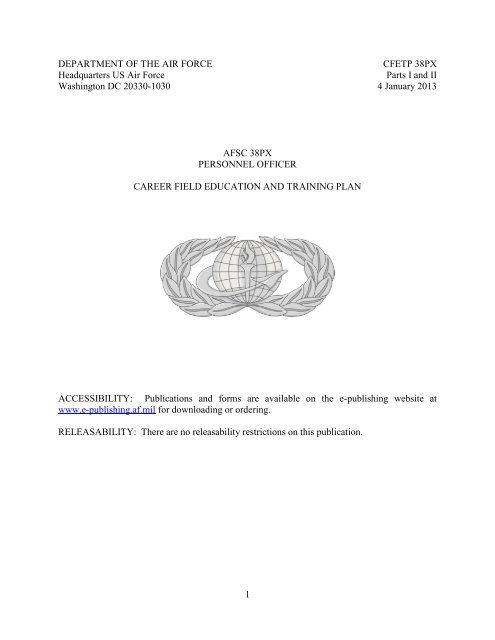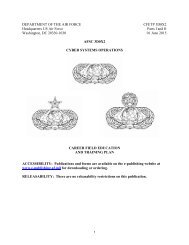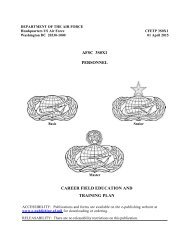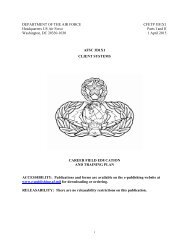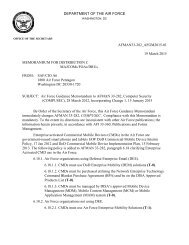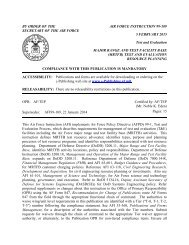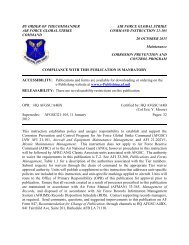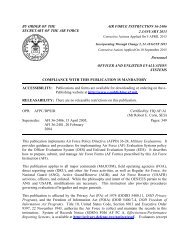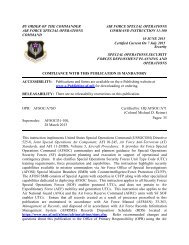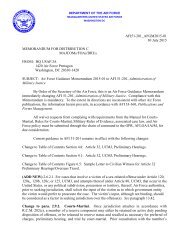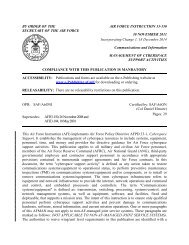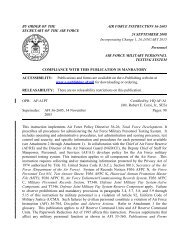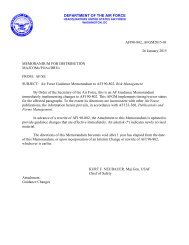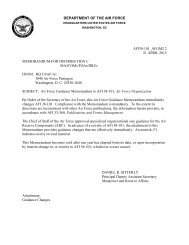1 DEPARTMENT OF THE AIR FORCE CFETP 38PX ... - Air Force Link
1 DEPARTMENT OF THE AIR FORCE CFETP 38PX ... - Air Force Link
1 DEPARTMENT OF THE AIR FORCE CFETP 38PX ... - Air Force Link
Create successful ePaper yourself
Turn your PDF publications into a flip-book with our unique Google optimized e-Paper software.
Professional Continuing Education (PCE). Specialized courses that educate and trainpersonnel to meet specific assignment requirements or to enhance job performance.Resource Constraints. Resource deficiencies such as money, facilities, time, manpower, andequipment that preclude desired training from being delivered.Special Experience Identifier (SEI). An alpha-numeric code that identifies special experienceand training not otherwise reflected in the classification system. SEIs complement otherclassification identifications.Unit Manpower Document (UMD). A detailed manpower listing, drawn from the manpowerdata system, reflecting the distribution of manpower allocations into a finite structure ofauthorizations and requirements by work center.Unit Type Code (UTC). A five-character alphanumeric designator uniquely identifying eachtype of deployable unit in the Armed <strong>Force</strong>s.Upgrade Training (UGT). Training that leads to the award of a higher skill level in an <strong>Air</strong><strong>Force</strong> specialty code6
Section A – General Information1. Purpose.The <strong>CFETP</strong> provides information necessary for Functional Managers (FM), Career FieldManagers (CFM), training managers, supervisors and trainers to plan, develop, manage andconduct an effective and efficient career field training program. The plan outlines the trainingindividuals in this AFS should receive to support their professional development and defines theskills necessary to progress throughout their careers. For purposes of this plan, training isdivided into initial and supplemental skills training and advanced and continuing education.Initial skills training (or waiver from CFM) is mandatory for award of the AFSC.2. Use.The plan will be used by CFM and supervisors at all levels to ensure comprehensive andcohesive training programs are available for each individual in the specialty.2.1. AETC education and training personnel will develop and revise formal resident, nonresident,field and exportable training based on requirements established by the users anddocumented in Part II of the <strong>CFETP</strong>. They will also work with the CFM to develop strategiesfor obtaining resources needed to provide the identified training.2.2. If CFMs develop education or training programs, they will ensure these programscomplement the <strong>CFETP</strong>.2.3. Each individual will complete the training requirements specified in this plan. The list ofcourses in Part II will be used as a reference to support training.3. Coordination and Approval.The CFM is approval authority for this <strong>CFETP</strong>. MAJCOM representatives and AETC trainingand education personnel will identify and coordinate on the career field training requirements.The AETC training manager for AFSC 38P will initiate an annual review of this document withMAJCOM functional managers to ensure currency and accuracy. The list of courses in Part IIwill provide a guide to eliminate duplicate education and training.Section B – <strong>Air</strong> <strong>Force</strong> Specialty (AFS) Progression and Information4. Specialty Summary.Define, develop, shape, sustain, and deliver mission-ready <strong>Air</strong>men across the Total <strong>Force</strong>.Responsibilities include defining <strong>Air</strong> <strong>Force</strong> Manpower and Organization Requirements,managing Human Resources, managing and providing Education and Training Requirements,regenerating <strong>Air</strong>men, feeding <strong>Air</strong>men, developing Human Capital Strategies, applying Laws andPolicies, compensating <strong>Air</strong>men, providing <strong>Force</strong> Readiness and Quality of Service Programs,and serves as senior staff advisor to commanders. Related DoD Occupational Groups: 150000,156000, 157000, 270200, 270300, 271400, 280500.5. Duties and Responsibilities.5.1. Formulate personnel plans and programs and develop policy to guide their implementationand execution. Translates program policy into directives, publications, and training manuals.7
5.2. Participate in total force adaptive planning and execution in support of combatantcommanders from peacetime through mobilization, contingency operations and demobilization.Access manpower, personnel, and equipment availability for UTC posturing and management.5.3. Develop, control, program and allocate manpower resources in support of the <strong>Air</strong> <strong>Force</strong>planning, programming, budgeting and execution process. Analyze and determine forcecomposition.5.4. Determine Total <strong>Force</strong> manpower requirements across the spectrum of <strong>Air</strong> <strong>Force</strong>capabilities. Employ industrial and management engineering methodologies to developmanpower determinants and standards. Manage allocation of military and civilian resourcesthrough execution and management of the UMD. Conduct management advisory studies.5.5. Develop, test, evaluate, and maintain <strong>Air</strong> <strong>Force</strong> recognized organization structure. Analyzeand process organization change actions to activate, inactivate, redesignate, and reorganize unitstructures.5.6. Administer <strong>Air</strong> <strong>Force</strong> performance management and productivity programs. Assess anddocument organizational performance. Advise on process improvement, best practices andrecognizes optimal performance.5.7. Oversee and conduct strategic sourcing studies.5.8. Develop and execute the full spectrum of total force personnel programs to accomplishaccession planning and processing, classification and utilization, promotion, recognition,evaluation, reenlistment, assignment action, retraining, retirement, disciplinary, forcedevelopment and force shaping programs.5.9. Establish <strong>Air</strong> <strong>Force</strong> education and training policy requirements. Manage programs toinclude developmental education, voluntary education, advanced academic education, promotiontesting, and libraries.5.10. Manage equal opportunity and sexual assault prevention and response programs. Assessclimate and advise commanders at all levels on the human relations environment. Providecounseling, education, and complaint processing.5.11. Lead and supervise contingency training and operations with an emphasis on specificcapabilities and processes focused on expeditionary organizations and command relationships,feeding operations, lodgment of forces, mortuary affairs, casualty reporting, force accountability,fitness, recreation, learning resource centers, protocol, and NAF resale operations for both peaceand wartime operations.5.12. Develop and administer fitness programs designed to keep the Total <strong>Force</strong> fit andregenerate <strong>Air</strong>man and families.5.13. Develop recreational programs to include sports management, tournaments, and specialentertainment designed to regenerate the Total <strong>Force</strong>.5.14. Lead Quality of Service programs and business operations. Establish and maintain soundappropriated and nonappropriated fund financial and corporate standards with internal controls.Establish short- and long-range plans to include growth and facility/equipment improvementand/or replacement.8
5.15. Develop, administer, and monitor <strong>Air</strong>man and Family Programs ensuring compliance withpolicies and standards.5.16. Institute customer service practices designed to meet the needs of commanders,supervisors and the force at large in peacetime and wartime operations.6. Skill and Career Progression.6.1. Once the officer successfully completes Initial Skills Training (IST), to include Officer FieldEducation, and meets the time requirements specified in the <strong>Air</strong> <strong>Force</strong> Officer ClassificationDocument (AFOCD), the functional manager at the organization or other functional equivalent(the FSS/CC at the base level, the MAJCOM A1 at the MAJCOM level, or the FOA/CC at theFOA level) will verify the officer has completed competency training requirements for award of38P3 and certify the officer for upgrade.6.2. Knowledge. Knowledge of the following core competencies is mandatory: <strong>Force</strong>Development, Career Development, <strong>Force</strong> Management, Civilian Employee Management,Requirements Determination, Organization Principles, Performance Management, ManpowerResource Allocation, Customer Support, Readiness, Food Operations, Fitness Operations,Lodging Operations, Recreation, Protocol, Resource Management, Mortuary Affairs, Casualty,SAPR, EO, Resiliency and Quality of Service Programs.6.3. Education 38P1. For entry into this specialty, undergraduate academic specialization infinance or accounting, economics, public administration, or human resource management isdesirable. Undergraduate degree in operations analysis, operations research, industrialengineering, management engineering, or mathematics, for 25% of 38P1 accessions ismandatory. Undergraduate academic specialization in business administration for 25% of 38P1accessions is mandatory.6.3.1. Education 38P1A. Undergraduate degree in mathematics, industrial engineering,management engineering, or operations research and analysis is mandatory.6.4. FSS Transition Training. The following course supports development of Personnel officers.This information is provided for situational awareness only.6.4.1. Bridge Training (FSS150): The purpose of this distance learning training is to providestudents with knowledge of the competencies within the A1 community. It provides a series ofsubject matter expert presentations of key programs a Personnel officer will encounter.6.5. Career Path.6.5.1. <strong>Air</strong> <strong>Force</strong> leaders are those officers who fully understand the operational Total <strong>Force</strong>, candemonstrate breadth and depth in their career field, have proven their ability to lead, and think ofthemselves as <strong>Air</strong>men first and as specialists in their field second. Successful senior officersbuild their careers one assignment at a time, always keeping in mind that at any time, theircurrent assignment is the most important assignment for career progression. Each assignmentoffers valuable experience to enhance breadth and develop depth.6.5.2. Professional Development. Experiencing the full breadth of opportunities in sufficientdepth normally requires a variety of assignments. Successful professional development isessential for those who will eventually hold top leadership positions in the <strong>Air</strong> <strong>Force</strong>. A9
alanced approach to professional development will produce officers with relevant expertise,diverse command experience, and an ability to link A1 occupational competencies to therequired capabilities in each assignment. The completion of professional military education,relevant advanced academic degree, and supplemental and continuing technical training andeducation facilitate this professional development.6.5.3. Role of 38P Leaders. Commanders and supervisors must take an active role in an officer’sprofessional development by providing mentoring and career planning. Officers should reviewcareer goals with their commander/supervisor or senior 38P officer during mentoring sessionsand performance feedback sessions. They should discuss career progression using the 38P careerpyramid in Figure 1.10
38P Career PathOfficer and CivilianPB-3GS 14-15WG/CCA1 & J1PB-2GS 7-8Exec OfficerProtocolJoint StaffCareer BroadeningHAF/MAJCOMDiv ChiefGroup/CDHAF/MAJCOM/FOA Branch ChiefSQ/CCHAF/MAJCOM/FOA Action OfficerIGHAF/MAJCOM ExecFSS DeputyOperations OfficerMAJCOM/FOA A<strong>OF</strong>light/CCFunctional InstructorEducation/Trng OfficerSDEAWC, ICAF, NWC, CCL, ELS, Foreign Schools, FellowshipsRAS/PASIDEACSC, AFIP, Joint Schools, AFIT, EWI, AAD (AFIT), ELDPC-NAF AOSection CCSection CCFOA Action OfficerContinuing Ed/TrainingPPB&E, MFSS400, MFSS250, MFSS275,Silver Flag (SCT)Advanced Functional CredentialsPDE: SOSContinuing Ed/TrainingSilver Flag (SCT), PERSCO, CWPC, DCAPES,DEOMI, SARC, FSS150,MFSS200, MFSS3XXAdvanced Functional CredentialsInitials Skills TrainingSilver Flag (<strong>OF</strong>E)Functional CredentialsFollow-on Unit TrainingFigure 7.1, 38P Officer Career Pyramid.I n t e g r i t y - S e r v i c e - E x c e l l e n c e17. Career Pyramid.7.1. The 38P officer career pyramid (Figure 7.1) graphically displays the types of opportunitiesavailable at different times in an officer’s career. The pyramid is only a guide; it cannot possiblyrepresent every single career path, and there is no single career path that guarantees success. ThePersonnel Officer Career Path Pyramid shows progression through a variety of jobs. Thispyramid should be used as a deliberate planning guide by senior leaders, commanders,supervisors, and individuals in conjunction with other planning tools, to include AFI 36-2110,Assignments. Early on, officers should develop a solid technical and operational experience baseand continually focus on gaining depth and breadth as their careers progress. Personnel officersmust be deliberately developed to apply their skills in an operational environment and articulatethe effects agile combat support has on the AF mission in operational (vs. technical) terms.Ultimately, an officer’s career path will be influenced by personal aspirations and the needs ofthe <strong>Air</strong> <strong>Force</strong>.11
7.2. Assignments. Each assignment should offer the 38P officer the opportunity to gain A1occupational competencies for their next assignment. The knowledge, skills, and abilities gainedfrom the A1 occupational competencies will develop an understanding of the force supportcapabilities and limitations. Assignments should prepare Personnel officers for command andleadership positions within the <strong>Air</strong> <strong>Force</strong>, Joint Commands, and the A1 community. Officersmust be able to operate in any environment, perform a variety of force support-related jobs andunderstand all aspects of support operations. The keys to success are breadth of experience,depth of knowledge, and high quality performance at every job level.7.3. Depth and Breadth. A company grade officer should develop depth early in their career withappropriate level assignments. Subsequently, officers will gradually broaden their baseline bothwithin and outside the personnel career field through career breadth and career broadening tours.Ideally, officers should gain depth as CGOs and gain breadth as they mature through field graderanks.7.4. The following courses are offered for the development of 38P officers. All courses aretaught by the Ira C. Eaker Center for Professional Development (Eaker Center) at Maxwell AFBAL, except where specified. General information about each course is provided.7.4.1. Personnel Officer Initial Skills Education Training (IST): a nine-week course held atKeesler AFB MS, is offered to new accessions and cross flow officers from other career fieldsand civilian equivalents. This course includes a capstone week in a field environment at TyndallAFB FL. The course provides a basic orientation to A1 doctrine, mission and capabilities in allareas of the personnel community and formal field training. Target Audience: new accessionsand Company Grade Officer cross flows. Field Grade officers require specific CFM approval toattend.The goal of IST is to:- Provide officers entering the 38P career field the skill sets and knowledge base to be successfulin their first 38P assignment and be successful in both 38F duties at home base as well as indeployed base operations.- Provide officers an understanding of the full scope of base level responsibilities across theentire 38P career field; that their understanding is more geared toward recognizing theinterrelationships between Field Support functions and how they need to be integrated to supportunit and AF missions, both at home stations and deployed.- Provide officers an understanding of the installation’s service population and what support isgenerally provided.- Provide officers sufficient knowledge of the career field and its responsibilities to be awardedthe 38P occupational badge; and serve as the platform for the first of several successive trainingevents that enable their progression in career development and responsibilities- Provide officers an understanding of their personal career development at the entry level of the38P career field, while gaining an initial appreciation of what it will eventually take to be a <strong>Force</strong>Support Senior Leader12
7.4.2. Protocol Fundamentals (MFSS200): a seven-day course providing an in-depth knowledgeof protocol presented from a base-level and deployed perspective. The course includesprocedures for administration, meetings and conference planning, entertaining and social events,ceremonies, funding sources, DV visits, hands-on training, flight line protocol, flag usage, andescort duties. Target Audience: newly assigned protocol officers; just-in-time training prior tobeing deployed.7.4.3. <strong>Air</strong> <strong>Force</strong> Sexual Assault Response Coordinator (SARC) Course (MAFHRMS140): a fivedaycourse preparing new SARCs to perform their duties and responsibilities. Target Audience:newly assigned SARCs.7.4.4. Manpower Staff Officer Course (MAFHRMS405): a 14-day course providing knowledgeand skills to help manpower organization staff officers effectively execute their roles andresponsibilities. The course also provides critical instruction on manpower programming andrequirements determination necessary to advise commanders and their staffs, and provides anoutline of manpower analysis and strategic sourcing as well as insight and perspective to performsuccessfully as a mid-level leader/staff officer at <strong>Air</strong> Staff, MAJCOM, and/or <strong>Air</strong> <strong>Force</strong>Manpower Agency. Target Audience: Active <strong>Air</strong> <strong>Force</strong>, <strong>Air</strong> <strong>Force</strong> Reserve, and <strong>Air</strong> NationalGuard officers, select senior NCOs, and civilians who occupy or have been selected for keymanpower management positions. Students selected by AFPC/MA.7.4.5. FSS <strong>Air</strong>man and Family Readiness Basic Course (MAFHRMS408): a one-week courseeducating and equipping all <strong>Air</strong>man and Family Readiness Center staff members with the skillsand knowledge to collaborate with base agencies and commanders to ensure deployments andfamily separations are efficiently maintained in a mission-ready status. During the course,participants will complete exercises based on real-life scenarios. Target Audience: NewReadiness NCOs and civilian staff members assigned to an <strong>Air</strong>man and Family ReadinessCenter.7.4.6. Mortuary Officers' Course (MFSS250): a five-day course mandatory for all primary andalternate installation mortuary affairs officers providing <strong>Force</strong> Support personnel with thetechnical aspects of mortuary affairs presented from a managerial perspective. Topics includecare and disposition of deceased, communications with Person Authorized to Direct Disposition(PADD) and higher headquarters, escort and transportation of remains, entitlements andeligibility criteria, search and recovery operations, <strong>Air</strong> <strong>Force</strong> and contract mortuaries, honorguard, and summary courts officer’s duties. Target Audience: Primary and alternate installationmortuary installation officers, preferably prior to assuming the duties.7.4.7. <strong>Force</strong> Support Contingency Course (MFSS275): a five-day course targeting personnelassigned to specific command and leadership UTCs during contingencies. Topics include A1doctrine, deployments, force beddown, base recovery, and peacetime contingency operationssuch as natural disaster recovery. This course is mandatory for deploying leadership teams(waiver authority is component command of the deployed location) and currently includesclassified site-specific briefings. Target Audience: Deploying leadership UTCs.7.4.8. FSS Flight Leadership Course Series (MFSS3XX): These courses are for officers andcivilian equivalents holding flight commander/chief positions.7.4.8.1. FSS Flight Leadership Course (MFSS300): a four-week e-learning course offered by theEaker Center, providing core leadership skills needed by all flight leaders, regardless of13
specialty. Topics include A1 doctrine, critical, creative and future thinking, APF and NAFfinancial management, marketing, customer service, readiness, project management,performance measurement, advising skills, ethical leadership, and force development. Thiscourse is a mandatory pre-requisite for MFSS315, MFSS317, MFSS318, and MFSS319. TargetAudience: CGOs and civilian equivalents selected to serve as FSS flight commander/chief.7.4.8.2. FSS Community Services Flight Leadership Course (MFSS315): a one-week courseproviding guidance on activity programs, financial indicators and standards, environmentalissues, programming, awards and recognition, crisis and humanitarian response and commanderexpectations. Target Audience: CGOs and civilian equivalents selected to serve as FSSCommunity Services Flight commander/chief.7.4.8.3. FSS <strong>Force</strong> Development Flight Leadership Course (MFSS316): a five-week blendedlearning course offered by the Eaker Center, providing guidance on education and trainingsection operations, library operations, professional development section operations, <strong>Air</strong>manLeadership School operations, test security, and awards and recognition. Target Audience:CGOs and civilian equivalents selected to serve as FSS <strong>Force</strong> Development Flightcommander/chief.7.4.8.4. FSS <strong>Air</strong>man and Family Services Flight Leadership Course (MFSS317): a one-weekcourse providing guidance on <strong>Air</strong>man and Family Readiness section operations, youth programs,child development programs, awards and recognition, crisis and humanitarian response andcommander expectations. Target Audience: CGOs and civilian equivalents selected to serve asFSS <strong>Air</strong>man and Family Services Flight commander/chief.7.4.8.5. FSS Sustainment Services Flight Leadership Course (MFSS318): a one-week courseproviding guidance on food operations, lodging operations, fitness and sports programs, awardsand recognition, crisis and humanitarian response and commander expectations. TargetAudience: CGOs and civilian equivalents selected to serve as FSS Sustainment Services Flightcommander/chief.7.4.8.6. FSS Manpower and Personnel Flight Leadership Course (MFSS319): a one-week courseproviding guidance on military personnel, manpower and organization, civilian personnel,awards and recognition, crisis and humanitarian response and commander expectations. TargetAudience: CGOs and civilian equivalents selected to serve as FSS Manpower and PersonnelFlight commander/chief.7.4.9. <strong>Force</strong> Support Operations Officer Course (MFSS375): a five-day course providingguidance on A1 doctrine, unit training management and oversight, squadron and installationreadiness, APF and NAF financial management, personnel resources, ethical leadership,inspections, advisory skills, honor guard, and crisis and humanitarian response. TargetAudience: military and civilian personnel selected to serve as FSS Operations Officer. Thiscourse will be transitioning to a four-week distance learning course in FY13.7.4.10. <strong>Force</strong> Support Squadron Leadership Course (MFSS400): a two-week mandatory for allFSS commanders and directors, prior to assuming the responsibility of FSS/CC/CL. Topicsinclude A1 doctrine, critical thinking, flight issues, APF and NAF financial management,inspections, readiness, manpower and organization, environmental issues, promotions, andFOA/CFM perspective. Target Audience: Field Grade Officers and civilian equivalent selectedto be FSS commanders, directors, and deputies.14
Section C – Proficiency Training Requirements8. Purpose.Proficiency training requirements in this career field are defined in terms of tasks and knowledgerequirements. This section outlines the specialty qualification requirements for entry, award andretention of each AFS level. The specific task and knowledge training requirements areidentified in the CTS, Training Course Index, and Follow-on training at Part II, Sections A, B,and E of this <strong>CFETP</strong>.9. Qualified Level (38P3).9.1. Training. For award of the 38P3 AFSC, completion of the Personnel Officer IST Courseincluding Officer Field Education (<strong>OF</strong>E) is mandatory (a waiver from the CFM is required if anyportion of the IST or <strong>OF</strong>E is not completed). A waiver from the CFM is required for Field GradeOfficers to attend IST.9.2. Experience. For award of 38P3 AFSC, a minimum of 24 months of experience ismandatory. The functional manager at the organization or other functional equivalent (theFSS/CC at the base level, the MAJCOM A1 at the MAJCOM level, or the FOA/CC at the FOAlevel) will verify the FSO has completed competency training requirements for award of 38P3and certify the officer for upgrade.10. Staff Level (38P4)10.1 Knowledge of 38P3 AFSC duties is mandatory.10.2. Education 38P4. Completion of 38P3 AFSC requirements is mandatory.10.3. Other. AFSC is awarded based on position. Officers must be appointed to a staff positionat the MAJCOM, Numbered <strong>Air</strong> <strong>Force</strong>, Field Operating Agency, Headquarters <strong>Air</strong> Staff, orCombatant Command to achieve the Staff Level 38P4 AFSC.Section D – Resource Constraints11. Purpose.This section identifies known resource constraints that preclude optimal/desired education andtraining from being developed or conducted.12. Constraints.With the exception of Personnel Officer IST, where quotas are determined and funded based onannually projected new accessions and company grade officer cross flows, all 38P education andtraining falls under <strong>Air</strong> University’s definition of PCE requirements. PCE quotas are eithercentrally funded under <strong>Air</strong> <strong>Force</strong> Educational Requirements Board (AFERB) process or unitfundedthrough MAJCOM or local installation. AFERB does not provide sufficient funding tocover all projected annual requirements for 38P professional continuing education.15
Subject KnowledgeLevelsTask KnowledgeLevelsTask PerformanceLevelsScale Value1234abcdABCDQUALITATIVE REQUIREMENTSPR<strong>OF</strong>ICIENCY CODE KEYDefinition:Can do simple parts of the task. Needs to be told or shown how to do most of thetask (EXTREMELY LIMITED)Can do most parts of the task. Needs only help on hardest parts (PARTIALLYPR<strong>OF</strong>ICIENT)Can do all parts of the task. Needs only spot check of complete work(COMPETENT)Can do the complete task quickly and accurately. Can tell or show others how todo the task (HIGHLY PR<strong>OF</strong>ICIENT)Can name parts, tools, and simple facts about the task (NOMENCLATURE)Can determine step-by-step procedures for doing the task (PROCEDURES)Can identify why and when the task must be done and why each step is needed(OPERATING PRINCIPLES)Can predict, isolate, and resolve problems with the task (COMPLETE<strong>THE</strong>ORY)Can identify basic facts and state general principles about the subject (FACTS)Can identify relationship of basic facts and state general principles about thesubject (PRINCIPLES)Can analyze facts and principles and draw conclusions about the subject(ANALYSIS)Can evaluate conditions and make proper decisions about the subject(EVALUATION)Explanations* A task knowledge scale value may be used alone or with a task performance scale value to define a level of knowledge for a specific task.(Example: b and 1b)** A subject knowledge scale value is used alone to define a level of knowledge for a subject not directly related to any specific task, or for asubject common to several tasks.- This mark is used alone instead of a scale value to show that no proficiency training is provided in the course or CDC.X This mark is used alone in course columns to show that training required but not given due to limitations in resources.NOTE: All tasks and knowledge items shown with a proficiency code are trained during war time.16
Task, Knowledge, and Proficiency Level1. INTRO TO A1 -1.1. Doctrine -1.1.1. A1 Doctrine B1.1.2. A1 Competencies A1.1.3. AF Institutional Competencies B1.1.4. A1 AFIs A1.2. A1 Structure -1.2.1. HAF A1 A1.2.2. A1 FOA B1.2.3. MAJCOM A1s B1.2.4. J1s A1.2.5. <strong>Air</strong> Reserve Components -1.2.5.1. Total <strong>Force</strong> Integration B1.2.5.2. OPCON/ADCON Relationship B1.2.5.3. Types of Association B1.3. <strong>Force</strong> Support Squadron Structure -1.3.1. MRS Organizational Chart A1.3.2. FSS Organizational Chart B1.3.3. Command Staff -1.3.4. Operations Officer -1.3.5. Resource Management -1.3.6. Marketing -1.3.7. Unit Training -1.3.8. Unit Readiness -1.3.9. IPR -1.3.10. Honor Guard -1.3.11. Manpower -1.3.12. Civilian Personnel -17
1.3.13. NAF-HR -1.3.14. Military Personnel -1.3.15. Food Operations -1.3.16. Fitness -1.3.17. Lodging -1.3.18. <strong>Air</strong>man and Family Readiness Center -1.3.19. Child Development Centers -1.3.20. Family Child Care -1.3.21. Youth Programs -1.3.22. Education and Training -1.3.23. Library -1.3.24. <strong>Air</strong>men Leadership School -1.3.25. First Term <strong>Air</strong>men's Center -1.3.26. Career Assistance Advisor -1.3.27. Golf Course -1.3.28. Outdoor Recreation -1.3.29. Arts and Craft Center -1.3.30. Bowling Center -1.3.31. Community Center -1.3.32. Aeroclub -1.3.33. Wing 38P Functional Areas (Protocol, SARC, EO) -1.4. Overview IT Systems A1.5. Career Development -1.5.1. Career Path B1.5.2. Development Team A1.5.3. Development Plan B1.5.4. Professional Continuing Education (PCE) A1.5.5. A1 Awards Program A1.5.6. In-House Training A18
1.6. <strong>Force</strong> Support Foundations -1.6.1. Customer Service B1.6.2. Critical Thinking A1.6.3. Resource Stewardship A1.6.4. Project Management A1.6.5. Time Management A1.6.6. Apply Continuous Process Improvement 2b1.6.7. Privacy Act/FOIA A1.6.8. Self Inspections A2. <strong>FORCE</strong> MANAGEMENT -2.1. Evaluations -2.1.1. Officer Performance Report Management B2.1.2. Enlisted Performance Report Management B2.1.3. Feedback Management B2.2. Promotions -2.2.1. Officer B2.2.1.1. Eligibility Criteria -2.2.1.2. 150-Day Process -2.2.1.3. Master Eligibility Lists (MELs) -2.2.1.4. OSBs -2.2.1.5. Officer Selection Record -2.2.1.6. Promotion Recommendation Form -2.2.1.7. MLRs -2.2.1.8. ARC -2.2.1.9. AF Promotion System (AFPROMS) -2.2.1.10. Releases -2.2.2. Enlisted B2.3. Reenlistments and Extensions -2.3.1. Selective Reenlistment Program A19
2.3.2. Career Job Reservations A2.4. Separation and Retirement -2.4.1. Voluntary A2.4.2. Involuntary A2.4.3. Retirement A2.4.4. High Year Tenure (HYT) A2.4.5. Stop Loss A2.4.6. <strong>Force</strong> Shaping Programs/Boards B2.5. Assignments -2.5.1. AMS B2.5.2. Assignments A2.5.3. EQUAL/EQUAL PLUS A2.5.4. Orders Process Management B2.6. Personnel Systems Management -2.6.1. Navigate BLSDM IT Tool b2.6.2. vMPF B2.6.3. Update MILPDS Functions 2b2.6.4. Interpret MAPs b2.6.5. Interpret TRs b2.6.6. vPCGR B2.6.7. Discoverer A2.7. Civilian Employee Management -2.7.1. NAF A2.7.2. APF A2.7.3. Supervisor Responsibility, Evaluations, Grievances, Labor Relations,Extensions, Recognition, Career Programs, Career Development, Discipline,Leave and Absences-2.8. Other Programs -2.8.1. Defense Enrollment and Eligibility Reporting Systems (DEERS) B20
2.8.2. Automated Record Management System (ARMS)/PRDA B2.8.3. Use Case Management System (CMS) b2.8.4. Personnel Reliability Program (PRP) B2.8.5. Dress and Appearance A2.8.6. Awards and Decorations B2.8.7. Special Trophies and Awards A2.8.8. PSD Guide/PSDMs A2.8.9. MyPers A2.8.10. Adverse Actions B3. <strong>FORCE</strong> DEFINITION -3.1. Manpower and Organization B3.2. Principles of AF Organization B3.3. AF Management Engineering Program Overview A3.4. Apply Manpower Standard 2b3.5. Interpret Unit Manpower Document 2b3.6. Unit Personnel Management Roster (UPMR) B3.7. Innovative Development Through Employee Awareness (IDEA) Program A3.8. Productivity and Excellence Awards and Programs A3.9. Overview of Management Improvement Tools and Techniques B4. <strong>FORCE</strong> SUSTAINMENT -4.1. Golden Eagle Standards A4.2. Food Operations -4.2.1. Food Service Mission A4.2.2. Food Operations Organization -4.2.2.1. DFAC B4.2.2.2. Clubs B4.2.3. Menu Cycles B4.2.4. Production Management B4.2.5. Daily Operations B21
4.2.6. Inventory Control B4.2.7. Food Safety and Sanitation Standards B4.2.8. ALOHA Point of Sales/CFS A4.2.9. Meal Prep Techniques B4.2.10. Flight and Ground Support Meals B4.2.11. WRM A4.2.12. Management Products -4.2.12.1. Interpret DFAC Spend Plan 2b4.2.12.2. Review Club Business Plan b4.2.12.3. Develop Club Income and Expense Budget 2b4.3. Fitness -4.3.1. Daily Operations B4.3.2. Fitness Assessments B4.4. Lodging -4.4.1. Daily Operations B4.4.2. Mission A4.5. NAF Financial Management -4.5.1. Financial Policies and Guidance B4.5.2. Financial Standards A4.5.3. NAF Categories (A, B, C) A4.5.4. Interpret NAF Financial Statement 2b4.5.5. MOA/MOU A4.5.6. NAF Council B4.6. Protocol Operations A4.7. Event Programming B5. <strong>FORCE</strong> DEVELOPMENT -5.1. Education and Training Mission A5.2. AF-Wide Developmental Education B22
5.3. Formal Training A5.4. Professional Development Education Management A5.5. Enlisted Specialty Training A5.6. Enlisted Upgrade Training (UGT) B5.7. Active Duty Service Commitment (ADSC) A5.8. Test Control A6. <strong>FORCE</strong> READINESS -6.1. <strong>Air</strong> <strong>Force</strong> Constructs -6.1.1. <strong>Force</strong> Concepts -6.1.1.1. Joint <strong>Force</strong> Concepts B6.1.1.2. Total <strong>Force</strong> Concepts B6.1.2. <strong>Air</strong> Expeditionary <strong>Force</strong> -6.1.2.1. AEF Concept B6.1.2.2. AEF Purpose B6.1.2.3. Unit Type Code (UTC) B6.1.2.4. Posturing B6.1.2.5. Coding B6.1.2.6. <strong>Force</strong> Modules B6.1.2.7. Contingency Sourcing Process B6.1.3. Agile Combat Support B6.1.4. Operational Planning -6.1.4.1. War and Mobilization Plan (WMP) B6.1.4.2. Operation Plan (OPLAN) -6.1.4.2.1. <strong>Force</strong> Support Annexes B6.1.4.2.2. Concept of Operations (CONOPS) B6.1.4.2.3. Other OPLAN Annexes B6.1.5. Develop BaS&E Site Planning Annex 2b6.1.6. Perform Crisis Response/Integrated Base Response Planning 2b6.1.7. Wartime Systems -23
6.1.7.1. Joint Operation Planning and Execution System (JOPES) A6.1.7.2. Deliberate Crisis Action Planning & Execution Segments (DCAPES) B6.2. <strong>Force</strong> Support Constructs -6.2.1. <strong>Force</strong> Support UTCs B6.2.2. <strong>Force</strong> Support <strong>Force</strong> Modules B6.2.3. EFSS Construct B6.2.4. <strong>Force</strong> Support Readiness Functions And Capabilities A6.2.5. Expeditionary <strong>Force</strong> Support Mission Planning -6.2.5.1. Perform Barebase Beddown Planning 2b6.2.5.2. Perform Surge Planning 2b6.2.5.3. Perform Sustainment Planning 2b6.2.5.4. Perform Drawdown Planning 2b6.3. Installation Personnel Readiness -6.3.1. Daily Operations B6.3.2. Shortfall/Reclama B6.3.3. Accountability -6.3.3.1. AFPAAS A6.3.3.2. Recall B6.3.3.3. Categories of Accountability (NEO, Homeland Defense, Contingencies) B6.3.3.4. Total <strong>Force</strong> Accountability B6.4. Unit Readiness -6.4.1. Readiness Reporting Tools (Status Of Resources & Training System (SORTS),AEF Reporting Tool (ART), Defense Readiness Reporting System (DRRS))6.4.2. DOC Statements A6.4.3. MISCAPs A6.4.4. Update AEF Association B6.4.5. Readiness Training B6.4.5.1. Home Station Readiness Training -6.4.5.2. Silver Flag/Combat Training -6.4.5.3. Ancillary Training Management -B24
6.5. Personnel Deployment Function -6.5.1. Concept (IDO, PDF, CDF) B6.5.2. Station Review (Eligibility, Chaplain, etc) B6.6. <strong>Air</strong>man and Family Readiness -6.6.1. Roles and Responsibilities A6.6.2. Emergency Family Assistance Care Coordinator B6.7. Casualty Program -6.7.1. Roles and Responsibilities A6.7.2. Casualty Report B6.7.3. Communications B6.7.4. Mass Casualty Procedures/CAST Team B6.7.5. Benefits A6.7.6. Case Files A6.8. Mortuary Affairs -6.8.1. Roles and Responsibilities (Mortuary Officer/Technician, AFMAO, Escort,Family Liaison Officer, and Summary Court Officer)6.8.2. Communications B6.8.3. Entitlements A6.8.4. Transportation and Travel A6.8.5. Honors A6.8.6. Perform Search and Recovery 2b6.8.7. Mass Fatality Operations B6.8.8. Case File Administration A6.9. Deployed <strong>Force</strong> Support Capability -6.9.1. Predeployment Planning B6.9.2. Total <strong>Force</strong> Accountability -6.9.2.1. Perform Reception Processing b6.9.2.2. Accountability Management B6.9.3. Contingency Reports -6.9.3.1. Produce SITREP 2bB25
6.9.3.2. Produce Casualty Reports 2b6.9.3.3. Produce Replacement Action Request 2b6.9.3.4. JPERSTAT B6.9.4. Redeploy Personnel B6.9.5. Forward Deploy Personnel B6.9.6. Personnel Sustainment Operations B6.9.7. Reachback Support B6.9.8. Manpower Management -6.9.8.1. Perform DRMD Management 2b6.9.8.2. Perform UTC Management Comparisons 2b6.9.8.3. Perform Provisional and Expeditionary Organizational Actions 2b6.9.8.4. Perform Requirements Determination 2b6.9.9. Perform Feeding Operations 2b6.9.10. Determine Fitness Operations 2b6.9.11. Perform Lodgement of <strong>Force</strong>s (Billeting/Lodging, Laundry, and Linen 2bExchange)6.9.12. Determine <strong>Air</strong>men Recreation Requirements 2b6.9.13. Connecting <strong>Air</strong>men to Home Station and Families B6.9.14. NAF Resale Operations B6.9.15. Perform Mortuary Affairs Operational Requirements 2b6.9.16. Hosting Official Functions Operations (Protocol) B6.9.17. <strong>Air</strong>men (Education and Training) Development -6.9.17.1. Library A6.9.17.2. Learning Resource Center A6.9.18. Perform Expeditionary Financial Management 2b6.9.19. Perform Expeditionary Procurement Actions 2b6.9.20. Programmatic Marketing Analysis and Implementation Plan A26
Section B – Training Course Index.1. Purpose. This section of the <strong>CFETP</strong> identifies available education and development courses.2. <strong>Air</strong> <strong>Force</strong> In-Residence Courses. Refer to the education and training course announcement(ETCA) for information on all courses listed on this index.2.1. Entry Level Awarding Course. Provide officers entering the 38P career field the skill setsand knowledge base to be successful in their first 38P assignment and be successful in both 38Pduties at home base as well as in deployed base operations. Provide officers an understanding ofthe full scope of base level responsibilities across the entire 38P career field; that theirunderstanding is more geared toward recognizing the interrelationships between Field Supportfunctions and how they need to be integrated to support unit and AF missions, both at homestations and deployed. Provide officers an understanding of the installation's service populationand what support is generally provided. Provide officers sufficient knowledge of the career fieldand its responsibilities to be awarded the 38P occupational badge; and serve as the platform forthe first of several successive training events that enable their progression in career developmentand responsibilities. Provide officers an understanding of their personal career development atthe entry level of the 38P career field, while gaining an initial appreciation of what it willeventually take to be a <strong>Force</strong> Support Senior Leader.Course No. Course Name Location UserE3OBR38P1 0A1A Personnel Officer IST Keesler AF2.2. Supplemental Skills CoursesCourse No. Course Name Location UserFSS150 Bridge Training Modules On-Line AFMFSS200 Protocol Fundamentals Course Eaker DoDMAFHRMS140 SARC Course Eaker AFMFSS250 Mortuary Officers' Course Eaker AFMFSS275 <strong>Force</strong> Support Contingency Course Eaker AF2.3. Advanced Skills Courses.Course No. Course Name Location UserMFSS300 FSS Flight Leadership Course On-Line AFMFSS315 FSS Community Services Flight Leadership Course Eaker AFMFSS316 FSS <strong>Force</strong> Development Flight Leadership Course On-Line AFMFSS317 FSS <strong>Air</strong>man & Family Services Flight Leadership Eaker AFMFSS318 FSS Sustainment Services Flight Leadership Course Eaker AFMFSS319 FSS Manpower & Personnel Flight Leadership Eaker AFMFSS375 <strong>Force</strong> Support Operations Officer Course Eaker AF27
MFSS400 FSS Leadership Course Eaker AFSection C - Support Materials.NOTE: There are currently no support material requirements. This area is reserved.Section D - MAJCOM-Unique Requirements.NOTE: There are currently no MAJCOM-unique technical training requirements. This area isreserved.Section E – Follow-On Unit Training.1. Follow-on unit training. Follow-on unit training is designed to teach new officers operatingprocedures, requirements, and common practices that will enhance knowledge already gained atIST.1.1. Concept. Ideally officers should complete IST prior to unit training. The intent of follow-onunit training is to provide a local training plan to familiarize officers with specific proceduresand operations.1.2. Training plan. The follow-on training is determined locally.1.3. Training Period. A CGO should be exposed to as many <strong>Force</strong> Support capabilities withintheir assignment. Commanders should look for opportunities to implement an officer utilizationplan that provides the CGO multiple 38P experiences during their assignment. Additionally,other opportunities such as Month of the Military Child, job fairs, end-of-year closeout, andmorale events will provide both warfighter capabilities and exposure to historically civilian-heldpositions. The <strong>CFETP</strong> will guide a commander in determining what capabilities need furtherdevelopment.1.4. Document the officer’s training in the <strong>CFETP</strong> with officer initials, supervisor initials, anddate.1.5. Supervisors will review the <strong>CFETP</strong> with officers.28
ProficiencyLevelTraineeInitials/dateSupervisorInitials/dateFollow-On Unit Training RequirementsTASK1. Intro to A1 -1.1. Doctrine -1.1.1. A1 Doctrine B1.1.2. A1 Competencies A1.1.3. AF Institutional Competencies B1.1.4. A1 AFIs A1.2. A1 Structure--HQ -1.2.1. HAF A1 A1.2.2. A1 FOA -1.2.2.1. Total <strong>Force</strong> Service Center-TX B1.2.2.2. Total <strong>Force</strong> Service Center-CO B1.2.3. MAJCOM A1s B1.2.4. Numbered <strong>Air</strong> <strong>Force</strong> A1s A1.2.5. J1s A1.2.6. <strong>Air</strong> Reserve Components -1.2.6.1. Total <strong>Force</strong> Integration B1.2.6.2. OPCON/ADCON Relationship B1.2.6.3. Types of Association B1.3. <strong>Force</strong> Support Structure--SQ -1.3.1. MRS Organizational Chart A1.3.2. FSS Organizational Chart B1.3.3. Command Staff -1.3.4. Operations Officer -1.3.5. Resource Management -1.3.6. Marketing -1.3.7. Unit Training -1.3.8. Unit Readiness -1.3.9. IPR -1.3.10. Honor Guard -1.3.11. Manpower -1.3.12. Civilian Personnel -1.3.13. NAF-HR -1.3.14. Military Personnel -1.3.15. Food Operations -1.3.16. Fitness -1.3.17. Lodging -29
ProficiencyLevelTraineeInitials/dateSupervisorInitials/dateTASK1.3.18. <strong>Air</strong>man and Family Readiness Center -1.3.19. Child Development Centers -1.3.20. Family Child Care -1.3.21. Youth Programs -1.3.22. Education and Training -1.3.23. Library -1.3.24. <strong>Air</strong>men Leadership School -1.3.25. First Term <strong>Air</strong>men's Center -1.3.26. Career Assistance Advisor -1.3.27. Golf Course -1.3.28. Outdoor Recreation -1.3.29. Arts and Craft Center -1.3.30. Bowling Center -1.3.31. Community Center -1.3.32. Aeroclub -1.3.33. Wing 38P Functional Areas (Protocol, SARC, EO) -1.4. Overview IT Systems A1.5. Career Development -1.5.1. Career Path B1.5.2. Development Team A1.5.3. Development Plan B1.5.4. Professional Continuing Education (PCE) A1.5.5. A1 Awards Program A1.5.6. In-House Training A1.6. <strong>Force</strong> Support Squadron Foundations -1.6.1. Customer Service B1.6.2. Critical Thinking A1.6.3. Resource Stewardship A1.6.4. Project Management A1.6.5. Time Management A1.6.6. Apply Continuous Process Improvement 2b1.6.7. Privacy Act/FOIA A1.6.8. Self Inspections A2. <strong>Force</strong> Management -2.1. Evaluations -2.1.1. Officer Performance Report Management B2.1.2. Enlisted Performance Report Management B2.1.3. Feedback Management B30
ProficiencyLevelTraineeInitials/dateSupervisorInitials/dateTASK2.2. Promotions -2.2.1. Officer B2.2.1.1. Eligibility Criteria -2.2.1.2. 150-Day Process -2.2.1.3. Master Eligibility Lists (MELs) -2.2.1.4. OSBs -2.2.1.5. Officer Selection Record -2.2.1.6. Promotion Recommendation Form -2.2.1.7. MLRs -2.2.1.8. ARC -2.2.1.9. AF Promotion System (AFPROMS) -2.2.1.10. Releases -2.2.2. Enlisted B2.3. Reenlistments and Extensions -2.3.1. Selective Reenlistment Program A2.3.2. Career Job Reservations A2.4. Separation and Retirement -2.4.1. Voluntary A2.4.2. Involuntary A2.4.3. Retirement A2.4.4. High Year Tenure (HYT) A2.4.5. Stop Loss A2.4.6. <strong>Force</strong> Shaping Programs/Boards B2.5. Assignments -2.5.1. AMS B2.5.2. Assignments A2.5.3. EQUAL/EQUAL PLUS A2.5.4. Orders Process Management B2.6. Personnel Systems Management -2.6.1. Navigate BLSDM IT Tool b2.6.2. vMPF B2.6.3. Update MILPDS Functions 2b2.6.4. Interpret MAPs b2.6.5. Interpret TRs b2.6.6. vPCGR B2.6.7. Discoverer A2.7. Civilian Employee Management -2.7.1. NAF A31
ProficiencyLevelTraineeInitials/dateSupervisorInitials/dateTASK2.7.2. APF A2.7.3. Supervisor Responsibility, Evaluations, Grievances, -Labor Relations, Extensions, Recognition, Career Programs,Career Development, Discipline, Leave and Absences2.8. Other Programs -2.8.1. Defense Enrollment and Eligibility Reporting Systems B(DEERS)2.8.2. Automated Record Management System (ARMS)/PRDA B2.8.3. Use Case Management System (CMS) b2.8.4. Personnel Reliability Program (PRP) B2.8.5. Dress and Appearance A2.8.6. Awards and Decorations B2.8.7. Special Trophies and Awards A2.8.8. PSD Guide/PSDMs A2.8.9. MyPers A2.8.10. Adverse Actions B3. <strong>Force</strong> Definition -3.1. Manpower and Organization B3.2. Principles of AF Organization B3.3. AF Management Engineering Program Overview A3.4. Apply Manpower Standard 2b3.5. Interpret Unit Manpower Document 2b3.6. Unit Personnel Management Roster (UPMR) B3.7. Innovative Development Through Employee Awareness A(IDEA) Program3.8. Productivity and Excellence Awards and Programs A3.9. Overview of Management Improvement Tools andBTechniques4. <strong>Force</strong> Sustainment -4.1. Golden Eagle Standards A4.2. Food Operations -4.2.1. Food Service Mission A4.2.2. Food Operations Organization -4.2.2.1. DFAC B4.2.2.2. Clubs B4.2.3. Menu Cycles B4.2.4. Production Management B4.2.5. Daily Operations B32
ProficiencyLevelTraineeInitials/dateSupervisorInitials/dateTASK4.2.6. Inventory Control B4.2.7. Food Safety and Sanitation Standards B4.2.8. ALOHA Point of Sales/CFS A4.2.9. Meal Prep Techniques B4.2.10. Flight and Ground Support Meals B4.2.11. WRM A4.2.12. Management Products -4.2.12.1. Interpret DFAC Plate Cost 2b4.2.12.2. Interpret DFAC Spend Plan 2b4.2.12.3. Review Club Business Plan b4.2.12.4. Develop Club Income and Expense Budget 2b4.3. Fitness -4.3.1. Daily Operations B4.3.2. Fitness Assessments B4.4. Lodging -4.4.1. Daily Operations B4.4.2. Mission A4.5. NAF Financial Management -4.5.1. Financial Policies and Guidance B4.5.2. Financial Standards A4.5.3. NAF Categories (A, B, C) A4.5.4. Interpret NAF Financial Statement 2b4.5.5. MOA/MOU A4.5.6. NAF Council B4.6. Protocol Operations A4.7. Event Programming B5. <strong>Force</strong> Development -5.1. Education and Training Mission A5.2. AF-Wide Developmental Education B5.3. Formal Training A5.4. Professional Development Education Management A5.5. Enlisted Specialty Training A5.6. Enlisted Upgrade Training (UGT) B5.7. Active Duty Service Commitment (ADSC) A5.8. Test Control A6. <strong>Force</strong> Readiness -6.1. <strong>Air</strong> <strong>Force</strong> Constructs -6.1.1. <strong>Force</strong> Concepts -33
ProficiencyLevelTraineeInitials/dateSupervisorInitials/dateTASK6.1.1.1. Joint <strong>Force</strong> Concepts B6.1.1.2. Total <strong>Force</strong> Concepts B6.1.2. <strong>Air</strong> Expeditionary <strong>Force</strong> -6.1.2.1. AEF Concept B6.1.2.2. AEF Purpose B6.1.2.3. Unit Type Code (UTC) B6.1.2.4. Posturing B6.1.2.5. Coding B6.1.2.6. <strong>Force</strong> Modules B6.1.2.7. Contingency Sourcing Process B6.1.3. Agile Combat Support B6.1.4. Operational Planning -6.1.4.1. War and Mobilization Plan (WMP) B6.1.4.2. Operation Plan (OPLAN) -6.1.4.2.1. <strong>Force</strong> Support Annexes B6.1.4.2.2. Concept of Operations (CONOPS) B6.1.4.2.3. Other OPLAN Annexes B6.1.5. Develop Bas&E Site Planning Annex 2b6.1.6. Perform Crisis Response/Integrated Base Response 2bPlanning6.1.7. Wartime Systems -6.1.7.1. Joint Operation Planning And Execution SystemA(JOPES)6.1.7.2. Deliberate Crisis Action Planning & ExecutionBSegments (DCAPES)6.2. <strong>Force</strong> Support Constructs -6.2.1. <strong>Force</strong> Support UTCs B6.2.2. <strong>Force</strong> Support <strong>Force</strong> Modules B6.2.3. EFSS Construct B6.2.4. <strong>Force</strong> Support Readiness Functions And Capabilities A6.2.5. Expeditionary <strong>Force</strong> Support Mission Planning -6.2.5.1. Perform Barebase Beddown Planning 2b6.2.5.2. Perform Surge Planning 2b6.2.5.3. Perform Sustainment Planning 2b6.2.5.4. Perform Drawdown Planning 2b6.3. Installation Personnel Readiness -6.3.1. Daily Operations B6.3.2. Shortfall/Reclama B6.3.3. Accountability -34
ProficiencyLevelTraineeInitials/dateSupervisorInitials/dateTASK6.3.3.1. AFPAAS A6.3.3.2. Recall B6.3.3.3. Categories of Accountability (NEO, HomelandBDefense, Contingencies)6.3.3.4. Total <strong>Force</strong> Accountability B6.4. Unit Readiness -6.4.1. Readiness Reporting Tools (Status Of Resources & BTraining System (SORTS), AEF Reporting Tool (ART),Defense Readiness Reporting System (DRRS))6.4.2. DOC Statements A6.4.3. MISCAPs A6.4.4. Update AEF Association B6.4.5. Readiness Training B6.4.5.1. Home Station Readiness Training -6.4.5.2. Silver Flag/Combat Training -6.4.5.3. Ancillary Training Management -6.5. Personnel Deployment Function -6.5.1. Concept (IDO, PDF, CDF) B6.5.2. Station Review (Eligibility, Chaplain, Etc) B6.6. <strong>Air</strong>man and Family Readiness -6.6.1. Roles and Responsibilities A6.6.2. Emergency Family Assistance Care Coordinator B6.7. Casualty Program -6.7.1. Roles and Responsibilities A6.7.2. Casualty Report B6.7.3. Communications B6.7.4. Mass Casualty Procedures / CAST Team B6.7.5. Benefits A6.7.6. Case Files A6.8. Mortuary Affairs -6.8.1. Roles And Responsibilities (MortuaryBOfficer/Technician, AFMAO, Escort, Family Liaison Officer,And Summary Court Officer)6.8.2. Communications B6.8.3. Entitlements A6.8.4. Transportation and Travel A6.8.5. Honors A6.8.6. Perform Search and Recovery 2b6.8.7. Mass Fatality Operations B35
ProficiencyLevelTraineeInitials/dateSupervisorInitials/dateTASK6.8.8. Case File Administration A6.9. Deployed <strong>Force</strong> Support Capability -6.9.1. Predeployment Planning B6.9.2. Total <strong>Force</strong> Accountability -6.9.2.1. Perform Reception Processing b6.9.2.2. Accountability Management B6.9.3. Contingency Reports -6.9.3.1. Produce SITREP 2b6.9.3.2. Produce Casualty Reports 2b6.9.3.3. Produce Replacement Action Request 2b6.9.3.4. JPERSTAT B6.9.4. Redeploy Personnel B6.9.5. Forward Deploy Personnel B6.9.6. Personnel Sustainment Operations B6.9.7. Reachback Support B6.9.8. Manpower Management -6.9.8.1. Perform DRMD Management 2b6.9.8.2. Perform UTC Management Comparisons 2b6.9.8.3. Perform Provisional and Expeditionary Organizational 2bActions6.9.8.4. Perform Requirements Determination 2b6.9.9. Perform Feeding Operations 2b6.9.10. Determine Fitness Operations 2b6.9.11. Perform Lodgement of <strong>Force</strong>s (Billeting/Lodging, 2bLaundry, and Linen Exchange)6.9.12. Determine <strong>Air</strong>men Recreation Requirements 2b6.9.13. Connecting <strong>Air</strong>men to Home Station and Families B6.9.14. NAF Resale Operations B6.9.15. Perform Mortuary Affairs Operational Requirements 2b6.9.16. Hosting Official Functions Operations (Protocol) B6.9.17. <strong>Air</strong>men (Education And Training) Development -6.9.17.1. Library A6.9.17.2. Learning Resource Center A6.9.18. Perform Expeditionary Financial Management 2b6.9.19. Perform Expeditionary Procurement Actions 2b6.9.20. Programmatic Marketing Analysis and Implementation APlanTable 2. Follow-On Unit Training Requirements.36
OrganizationalDesign andDevelopmentWorkforcePlanning<strong>Force</strong>DevelopmentPerformanceManagementProgramManagement<strong>Air</strong>manSupportSection F – Training Tasks <strong>Link</strong>ed to Occupational Competencies.The A1 Competency Framework effort was initiated by AF/A1XX to support the future of theA1 organization. The <strong>Air</strong> <strong>Force</strong> Mission and Strategy sets the direction for the <strong>Air</strong> <strong>Force</strong>’sbusiness, defines their goals, and sets priorities. In support of this mission and strategy, the highlevelA1 Competency Framework was developed.TASK1. INTRO TO A11.1. Doctrine1.1.1. A1 Doctrine1.1.2. A1 Competencies1.1.3. AF Institutional Competencies1.1.4. A1 AFIs1.2. A1 Structure--HQ1.2.1. HAF A11.2.2. A1 FOAs1.2.2.1. Total <strong>Force</strong> Service Center-TX1.2.2.2. Total <strong>Force</strong> Service Center-CO1.2.3. MAJCOM A1s1.2.4. Numbered <strong>Air</strong> <strong>Force</strong> A1s1.2.5. J1s1.2.6. <strong>Air</strong> Reserve Components1.2.6.1. Total <strong>Force</strong> Integration1.2.6.2. OPCON/ADCON Relationship1.2.6.3. Type of Associations1.3. <strong>Force</strong> Support Structure--SQ1.3.1. MRS Organizational Chart1.3.2. FSS Organizational Chart1.3.3. Command Staff1.3.4. Operations Officer1.3.5. Resource Management1.3.6. Marketing1.3.7. Unit Training1.3.8. Unit Readiness37
OrganizationalDesign andDevelopmentWorkforcePlanning<strong>Force</strong>DevelopmentPerformanceManagementProgramManagement<strong>Air</strong>manSupportTASK1.3.9. IPR1.3.10. Honor Guard1.3.11. Manpower1.3.12. Civilian Personnel1.3.13. NAF-HR1.3.14. Military Personnel1.3.15. Food Operations1.3.16. Fitness1.3.17. Lodging1.3.18. <strong>Air</strong>man and Family ReadinessCenter1.3.19. Child Development Centers1.3.20. Family Child Care1.3.21. Youth Programs1.3.22. Education and Training1.3.23. Library1.3.24. <strong>Air</strong>men Leadership School1.3.25. First Term <strong>Air</strong>men's Center1.3.26. Career Assistance Advisor1.3.27. Golf Course1.3.28. Outdoor Recreation1.3.29. Arts and Craft Center1.3.30. Bowling Center1.3.31. Community Center1.3.32. Aeroclub1.3.33. Wing 38P Functional Areas(Protocol, SARC, EO)1.4. Overview IT Systems1.5. Career Development1.5.1. Career Path1.5.2. Development Team1.5.3. Development Plan1.5.4. Professional Continuing Education(PCE)38
OrganizationalDesign andDevelopmentWorkforcePlanning<strong>Force</strong>DevelopmentPerformanceManagementProgramManagement<strong>Air</strong>manSupportTASK1.5.5. A1 Awards Program1.5.6. In-House Training1.6. <strong>Force</strong> Support Squadron Foundations1.6.1. Customer Service1.6.2. Critical Thinking1.6.3. Resource Stewardship1.6.4. Project Management1.6.5. Time Management1.6.6. Apply Continuous ProcessImprovement1.6.7. Privacy Act/FOIA1.6.8. Self Inspections2. <strong>Force</strong> Management2.1. Evaluations2.1.1. Officer Performance ReportManagement2.1.2. Enlisted Performance ReportManagement2.1.3. Feedback Management2.2. Promotions2.2.1. Officer2.2.1.1. Eligibility Criteria2.2.1.2. 150-Day Process2.2.1.3. Master Eligibility Lists (MELs)2.2.1.4. OSBs2.2.1.5. Officer Selection Record2.2.1.6. Promotion Recommendation Form2.2.1.7. MLRs2.2.1.8. ARC2.2.1.9. AF Promotion System(AFPROMS)2.2.1.10. Releases2.2.2. Enlisted2.3. Reenlistments and Extensions39
OrganizationalDesign andDevelopmentWorkforcePlanning<strong>Force</strong>DevelopmentPerformanceManagementProgramManagement<strong>Air</strong>manSupportTASK2.3.1. Selective Reenlistment Program2.3.2. Career Job Reservations2.4. Separation and Retirement2.4.1. Voluntary2.4.2. Involuntary2.4.3. Retirement2.4.4. High Year Tenure (HYT)2.4.5. Stop Loss2.4.6. <strong>Force</strong> Shaping Programs/Boards2.5. Assignments2.5.1. AMS2.5.2. Assignments2.5.3. EQUAL/EQUAL PLUS2.5.4. Orders Process Management2.6. Personnel Systems Management2.6.1. Navigate BLSDM IT Tool2.6.2. vMPF2.6.3. Update MILPDS Functions2.6.4. Interpret MAPs2.6.5. Interpret TRs2.6.6. vPCGR2.6.7. Discoverer2.7. Civilian Employee Management2.7.1. NAF2.7.2. APF2.7.3. Supervisor Responsibility,Evaluations, Grievances, Labor Relations,Extensions, Recognition, Career Programs,Career Development, Discipline, Leaveand Absences2.8. Other Programs2.8.1. Defense Enrollment and EligibilityReporting Systems (DEERS)2.8.2. Automated Record Management40
OrganizationalDesign andDevelopmentWorkforcePlanning<strong>Force</strong>DevelopmentPerformanceManagementProgramManagement<strong>Air</strong>manSupportTASKSystem (ARMS) / PRDA2.8.3. Use Case Management System(CMS)2.8.4. Personnel Reliability Program (PRP)2.8.5. Dress and Appearance2.8.6. Awards and Decorations2.8.7. Special Trophies and Awards2.8.8. PSD Guide/PSDMs2.8.9. MyPers2.8.10. Adverse Actions3. <strong>Force</strong> Definition3.1. Manpower and Organization3.2. Principles of AF Organization3.3. AF Management Engineering ProgramOverview3.4. Apply Manpower Standard3.5. Interpret Unit Manpower Document3.6. Unit Personnel Management Roster(UPMR)3.7. Innovative Development ThroughEmployee Awareness (IDEA) Program3.8. Productivity and Excellence Awardsand Programs3.9. Overview of ManagementImprovement Tools and Techniques4. <strong>Force</strong> Sustainment4.1. Golden Eagle Standards4.2. Food Operations4.2.1. Food Service Mission4.2.2. Food Operations Organization4.2.2.1. DFAC4.2.2.2. Clubs4.2.3. Menu Cycles4.2.4. Production Management4.2.5. Daily Operations41
OrganizationalDesign andDevelopmentWorkforcePlanning<strong>Force</strong>DevelopmentPerformanceManagementProgramManagement<strong>Air</strong>manSupportTASK4.2.6. Inventory Control4.2.7. Food Safety and SanitationStandards4.2.8. ALOHA Point of Sales/CFS4.2.9. Meal Prep Techniques4.2.10. Flight and Ground Support Meals4.2.11. WRM4.2.12. Management Products4.2.12.1. Interpret DFAC Plate Cost4.2.12.2. Interpret DFAC Spend Plan4.2.12.3. Review Club Business Plan4.2.12.4. Develop Club Income andExpense Budget4.3. Fitness4.3.1. Daily Operations4.3.2. Fitness Assessments4.4. Lodging4.4.1. Daily Operations4.4.2. Mission4.5. NAF Financial Management4.5.1. Financial Policies and Guidance4.5.2. Financial Standards4.5.3. NAF Categories (A, B, C)4.5.4. Interpret NAF Financial Statement4.5.5. MOA/MOU4.5.6. NAF Council4.6. Protocol Operations4.7. Event Programming5. <strong>Force</strong> Development5.1. Education and Training Mission5.2. AF-Wide Developmental Education5.3. Formal Training5.4. Professional Development EducationManagement42
OrganizationalDesign andDevelopmentWorkforcePlanning<strong>Force</strong>DevelopmentPerformanceManagementProgramManagement<strong>Air</strong>manSupportTASK5.5. Enlisted Specialty Training5.6. Enlisted Upgrade Training (UGT)5.7. Active Duty Service Commitment(ADSC)5.8. Test Control6. <strong>Force</strong> Readiness6.1. <strong>Air</strong> <strong>Force</strong> Constructs6.1.1. <strong>Force</strong> Concepts6.1.1.1. Joint <strong>Force</strong> Concepts6.1.1.2. Total <strong>Force</strong> Concepts6.1.2. <strong>Air</strong> Expeditionary <strong>Force</strong>6.1.2.1. AEF Concept6.1.2.2. AEF Purpose6.1.2.3. Unit Type Code (UTC)6.1.2.4. Posturing6.1.2.5. Coding6.1.2.6. <strong>Force</strong> Modules6.1.2.7. Contingency Sourcing Process6.1.3. Agile Combat Support6.1.4. Operational Planning6.1.4.1. War and Mobilization Plan (WMP)6.1.4.2. Operation Plan (OPLAN)6.1.4.2.1. <strong>Force</strong> Support Annexes6.1.4.2.2. Concept Of Operations(CONOPS)6.1.4.2.3. Other OPLAN Annexes6.1.5. Develop Bas&E Site PlanningAnnex6.1.6. Perform Crisis Response/IntegratedBase Response Planning6.1.7. Wartime Systems6.1.7.1. Joint Operation Planning andExecution System (JOPES)43
OrganizationalDesign andDevelopmentWorkforcePlanning<strong>Force</strong>DevelopmentPerformanceManagementProgramManagement<strong>Air</strong>manSupportTASK6.1.7.2. Deliberate Crisis Action Planning& Execution Segments (DCAPES)6.2. <strong>Force</strong> Support Constructs6.2.1. <strong>Force</strong> Support UTCs6.2.2. <strong>Force</strong> Support <strong>Force</strong> Modules6.2.3. EFSS Construct6.2.4. <strong>Force</strong> Support Readiness FunctionsAnd Capabilities6.2.5. Expeditionary <strong>Force</strong> SupportMission Planning6.2.5.1. Perform Barebase BeddownPlanning6.2.5.2. Perform Surge Planning6.2.5.3. Perform Sustainment Planning6.2.5.4. Perform Drawdown Planning6.3. Installation Personnel Readiness6.3.1. Daily Operations6.3.2. Shortfall/Reclama6.3.3. Accountability6.3.3.1. AFPAAS6.3.3.2. Recall6.3.3.3. Categories of Accountability(NEO, Homeland Defense, Contingencies)6.3.3.4. Total <strong>Force</strong> Accountability6.4. Unit Readiness6.4.1. Readiness Reporting Tools (StatusOf Resources & Training System(SORTS), AEF Reporting Tool (ART),Defense Readiness Reporting System(DRRS))6.4.2. DOC Statements6.4.3. MISCAPs6.4.4. Update AEF Association6.4.5. Readiness Training6.4.5.1. Home Station Readiness Training44
OrganizationalDesign andDevelopmentWorkforcePlanning<strong>Force</strong>DevelopmentPerformanceManagementProgramManagement<strong>Air</strong>manSupportTASK6.4.5.2. Silver Flag/Combat Training6.4.5.3. Ancillary Training Management6.5. Personnel Deployment Function6.5.1. Concept (IDO, PDF, CDF)6.5.2. Station Review (Eligibility,Chaplain, etc)6.6. <strong>Air</strong>man and Family Readiness6.6.1. Roles and Responsibilities6.6.2. Emergency Family Assistance CareCoordinator6.7. Casualty Program6.7.1. Roles and Responsibilities6.7.2. Casualty Report6.7.3. Communications6.7.4. Mass Casualty Procedures/CASTTeam6.7.5. Benefits6.7.6. Case Files6.8. Mortuary Affairs6.8.1. Roles and Responsibilities (MortuaryOfficer/Technician, AFMAO, Escort,Family Liaison Officer, and SummaryCourt Officer)6.8.2. Communications6.8.3. Entitlements6.8.4. Transportation and Travel6.8.5. Honors6.8.6. Perform Search and Recovery6.8.7. Mass Fatality Operations6.8.8. Case File Administration6.9. Deployed <strong>Force</strong> Support Capability6.9.1. Predeployment Planning6.9.2. Total <strong>Force</strong> Accountability6.9.2.1. Perform Reception Processing6.9.2.2. Accountability Management45
OrganizationalDesign andDevelopmentWorkforcePlanning<strong>Force</strong>DevelopmentPerformanceManagementProgramManagement<strong>Air</strong>manSupportTASK6.9.3. Contingency Reports6.9.3.1. Produce SITREP6.9.3.2. Produce Casualty Reports6.9.3.3. Produce Replacement ActionRequest6.9.3.4. JPERSTAT6.9.4. Redeploy Personnel6.9.5. Forward Deploy Personnel6.9.6. Personnel Sustainment Operations6.9.7. Reachback Support6.9.8. Manpower Management6.9.8.1. Perform DRMD Management6.9.8.2. Perform UTC ManagementComparisons6.9.8.3. Perform Provisional andExpeditionary Organizational Actions6.9.8.4. Perform RequirementsDetermination6.9.9. Perform Feeding Operations6.9.10. Determine Fitness Operations6.9.11. Perform Lodgement of <strong>Force</strong>s(Billeting/Lodging, Laundry, and LinenExchange)6.9.12. Determine <strong>Air</strong>men RecreationRequirements6.9.13. Connecting <strong>Air</strong>men to HomeStation and Families6.9.14. NAF Resale Operations6.9.15. Perform Mortuary AffairsOperational Requirements6.9.16. Hosting Official FunctionsOperations (Protocol)6.9.17. <strong>Air</strong>men (Education and Training)Development6.9.17.1. Library6.9.17.2. Learning Resource Center46
OrganizationalDesign andDevelopmentWorkforcePlanning<strong>Force</strong>DevelopmentPerformanceManagementProgramManagement<strong>Air</strong>manSupportTASK6.9.18. Perform Expeditionary FinancialManagement6.9.19. Perform ExpeditionaryProcurement Actions6.9.20. Programmatic Marketing Analysisand Implementation PlanTable 3. Training Tasks <strong>Link</strong>ed to Occupational Competencies.47


